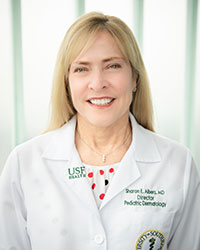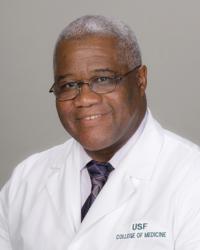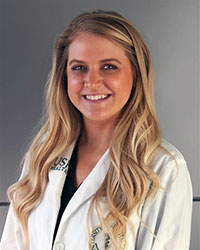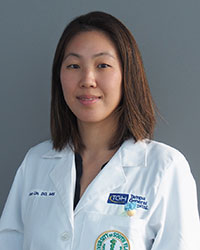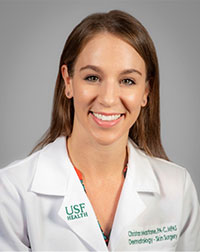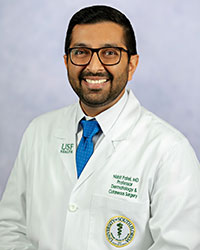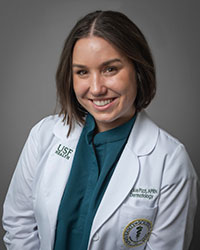Dermatology & Cutaneous Surgery
Phototherapy Center
Photo light therapy can improve existing lesions, reduce likelihood of new lesions and, in some cases, offer near total clearing of the disease process.
PUVA and narrow band UVB photo light therapy are used for the treatment of various skin diseases and disorders, such as psoriasis, eczema, itching and hard to treat atopic dermatitis. PUVA stands for psoralen and ultraviolet A (psoralen is a light-sensitive drug that absorbs ultraviolet) while UVB indicated ultraviolet B.
USF Health Dermatology is proud to be one of the few providers in the Tampa Bay area to offer this technology.
What to Expect
-
- Improvement of existing lesions.
- Reduction of new lesions.
- Remission – in many cases phototherapy has resulted in near-total clearing of the disease process. The duration of this remission varies with each patient. Maintenance therapy may be required.
-
- Wear the same style under garments to each appointment. This would include the jock strap for men and bra/underwear for women. (Wearing the same style can prevent burns)
- Men should have a jockstrap to protect areas prone to burn.
- Apply sunscreen to face (and areolas in women) if these areas are not being treated.
- Do not wear any jewelry, if you do please remove all necklaces, bracelets, and watches prior to entering booth.
-
- Tell the nurse if ANY medications have changed. (This includes over the counter medications, supplements, herbal supplements and ALL topical medications).
- Do not start any new herbal medications while you are undergoing phototherapy.
- Certain medicines may make you more sensitive to light and more apt to burn.
- The nurse will ask you to wear protective devices over your head and neck and protective goggles during the treatment. Once started these need to be worn EVERY treatment to prevent burning.
- It is VERY IMPORTANT that you keep every appointment. Missing appointments will decrease the effectiveness of the treatment.
-
- Wash treated areas gently with mild soaps, such as Cetaphil Gentle Cleanser.
- Do no rub, massage or pick at treated skin.
- You may use aloe or a moisturizer for dry itchy irritated skin.
- Over the counter antihistamines can be used to ease the itching that may occur.
- Avoid sun exposure as much as possible. Sunscreen at least SPT 30 is recommended daily.
- Perform regular self-skin exams for signs and symptoms of skin cancers at least monthly.
- Side effects such as itchiness, redness, dryness of the skin, burning and very rarely blistering may occur.
-
- Signs of infections, including fever and chills.
- Redness around the skin lesions or any discharge and/or unusual growths, moles or skin sores.
- Severe skin redness, burning, pain, peeling, swelling or blistering.
- Side affects you experienced due to the treatment continue or worsen.
-
- The most common side effect of this therapy is UVB-induced sunburn. This may occur at any time during therapy. Certain drugs may also cause you to get sun burnt. Please let your doctor/nurse know of ANY medications you are taking, or any that you begin while undergoing therapy.
- It is possible with any form of UV light that an increased incidence of skin cancer may occur later in some patients, usually only with many UV light treatments, especially in fair-skinned individuals.
- UV treatments may cause dryness and itching.
- UV treatments age the skin over time and may increase freckles and pigmentation and wrinkles of the skin.
- UV rays may damage the eyes and increase your risk of cataracts. This is PREVENTABLE with the goggles given to you that you are required to wear during treatment.
- UV light may cause a flare of rosacea, fever blisters and mouth sores in susceptible people.
- Long-term UV exposure to unprotected genital area in men may cause an increase in genital cancer. Men WILL wear jock strap in treatment.
- UV light may cause exacerbation of other skin conditions (such as Lupus).
-
- This treatment is NOT a cure, but can effectively control or improve the disease.
- Each condition and patient will vary in the number of treatments needed per week and the time it will take to reach clearing.
- Typically, treatments start with only a few seconds of light exposure and increase gradually as determined by the nursing staff.
- It may take 15-25 treatments or longer to note improvement. Not all patients will clear completely.
Meet Our Experts
-
Melissa Leto, PA-C
Melissa Leto, PA-C
